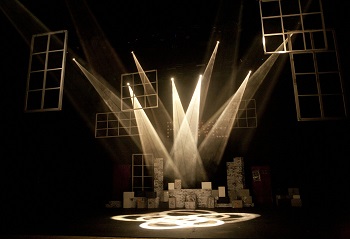
Stagecraft, Performance, and Illumination in Theatre Magic

The world of theatre has always been a vibrant amalgamation of art, technology, and storytelling, with stagecraft and illumination playing pivotal roles in captivating audiences and enhancing performances. One of the most revolutionary developments in this realm was the advent of limelight theatre in the 19th century. This remarkable innovation not only transformed the way performances were staged but also altered the very essence of theatrical lighting. From simulating natural light to creating mood and atmosphere, limelight emerged as a cornerstone of theatrical technology.
As performers took to the stage, the way they engaged with the audience changed dramatically due to the advances in illumination techniques. The brilliance of limelight and its rich history illustrate the interplay between technology and the theatrical experience, paving the way for modern stagecraft. In the following sections, we will delve into the origins of limelight, its technical marvels, and its lasting impact on theatre as we explore the journey from its inception to the innovations in illumination that define contemporary performances.
The Origins of Limelight in Theatre
The inception of limelight theatre is credited to the groundbreaking work of Thomas Drummond in 1816. Drummond discovered that by heating calcium oxide, he could produce an intense white light. This was achieved by directing the flame from a gas burner at the heated solid, creating a luminous effect capable of lighting even the dimmest theatre spaces. The rapid dissemination and popularity of this technology in theatres throughout Europe and America during the 1860s sparked a revolution in the way plays were delivered and experienced.
The Technical Marvel of Calcium Oxide Illumination
At the heart of limelight’s brilliance was its unique construction and operation. Calcium oxide, when subjected to flame, could emit a dazzling light far superior to traditional oil lamps and candles. This heralded a new era for stage lighting. The light produced was not only bright but also remarkably soft, allowing for a smoother on-stage appearance that simulated the effects of natural light. Furthermore, limelight could be focused and directed through adjustable apparatus, enabling lights to be aimed at specific areas or performers, thus enhancing the storytelling experience.
Applications of Limelight: Simulating Natural Light
One of the prominent applications of limelight theatre was its ability to replicate the effects of daylight and moonlight. This capability allowed playwrights and directors to experiment with lighting to evoke the right emotions and set the atmosphere for different scenes. The shimmering blue hues of moonlight or the warm glow of a sunny afternoon could be achieved with precision, enabling a seamless transition between scenes that appeared more lifelike and immersive.
The Transition from Limelight to Electric Lighting
While limelight represented a significant advancement in stage lighting, it came with its limitations. The maintenance and operation of gas cylinders and the constant need for an operator to manage the technical aspects made performances more challenging. By the late 19th century, as electric lighting technologies evolved, particularly with the invention of the electric arc spotlight, theatres began the transition away from limelight. This shift not only simplified the operating process but also expanded the artistic possibilities available to directors and stage designers.
The Role of Stagecraft in Enhancing Performance
Stagecraft has evolved tremendously alongside illumination technologies. The integration of advanced lighting solutions enhances how stories are told on stage and deepens audience engagement. With electric lighting, designers could utilize color gels, dimmers, and more complex rigging systems, allowing for dynamic lighting changes throughout a performance. This new flexibility liberated directors and actors to explore a broader range of emotions and storytelling techniques.
The Impact of Illumination on Audience Experience
Illumination plays a crucial role in shaping the audience's experience in the theatre. The contrasting effects of light and shadow can create tension, highlight pivotal moments, or convey a character's emotional state. Limelight theatre laid the groundwork for understanding how light influences perception and emotion. The profound impact of light on mood remains a vital consideration for contemporary theatrical productions, ensuring that lighting design remains an integral part of the storytelling process.
Innovations in Theatrical Lighting Techniques
As technology progressed, the field of theatrical lighting saw continuous innovation. The emergence of LED lighting, moving lights, and automated systems has revolutionized how lighting is used creatively in theatre. These advancements enable designers to create complex, shifting atmospheres on stage, crafting experiences that were once unimaginable. Moreover, computerized lighting boards allow for precise control and synchronization with sound and effects, further enhancing the depths of the theatrical experience.
Conclusion: The Evolution of Stagecraft and Illumination
From its humble beginnings with limelight in the early 19th century to today's sophisticated lighting designs, the journey of illumination in the theatre reflects the broader evolution of stagecraft. Each advancement has not only improved the technical aspects of performances but has also expanded the artistic possibilities available to theatre makers. As we continue to explore the boundaries of performance and illumination, it remains evident that the legacy of limelight will always shine brightly in the world of theatre.
Did you find this article helpful? Stagecraft, Performance, and Illumination in Theatre Magic See more here Education.
Leave a Reply






Related posts